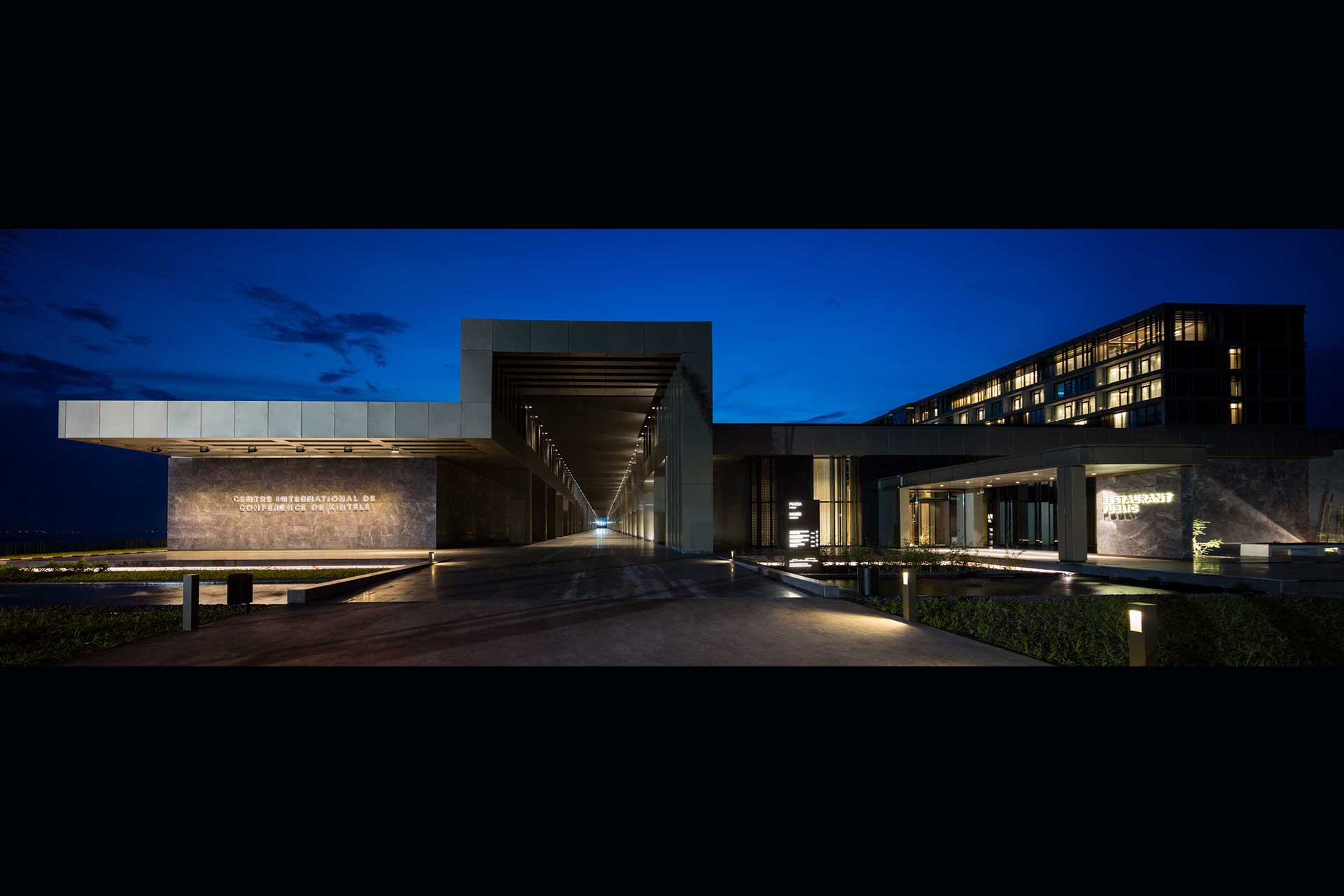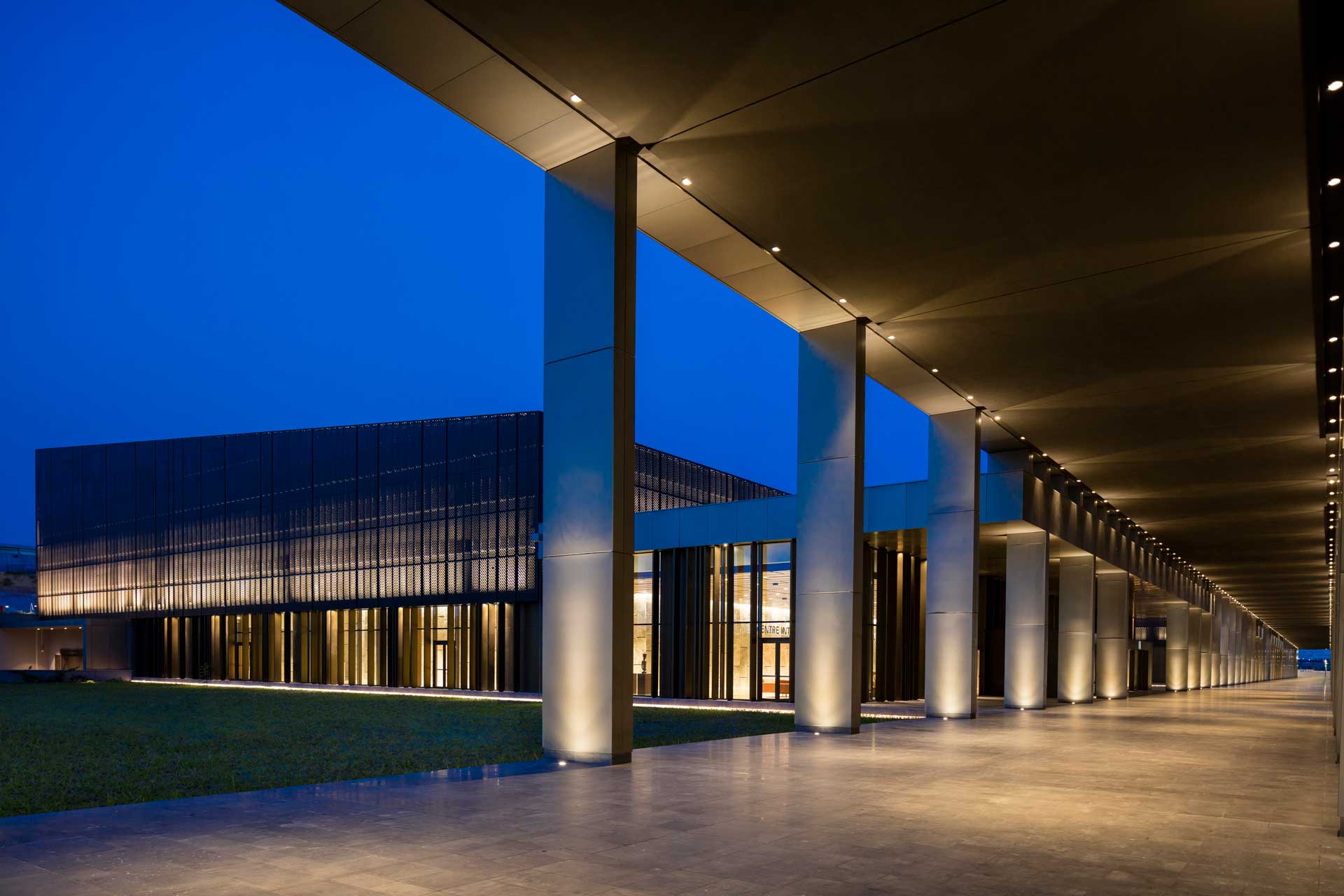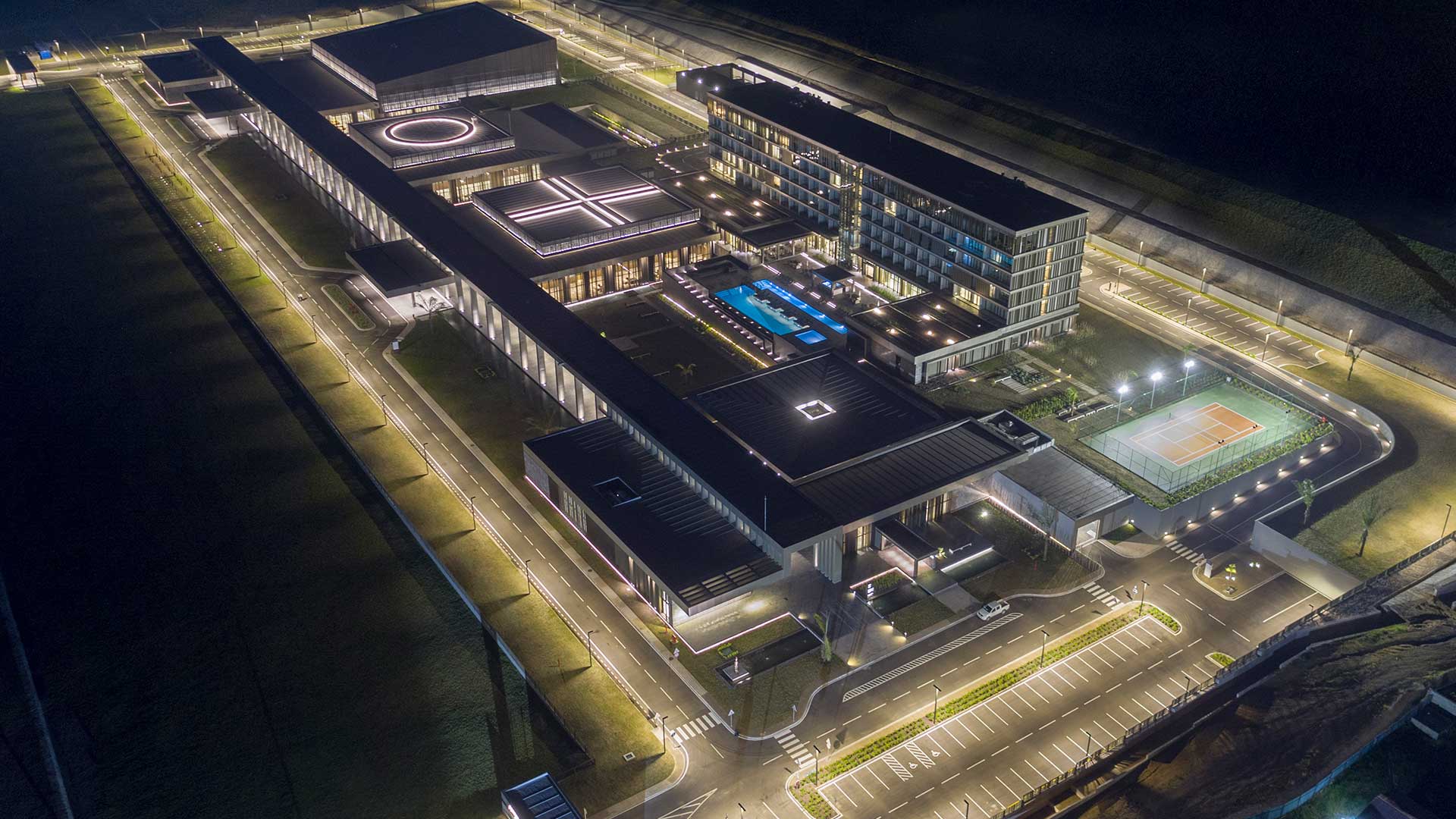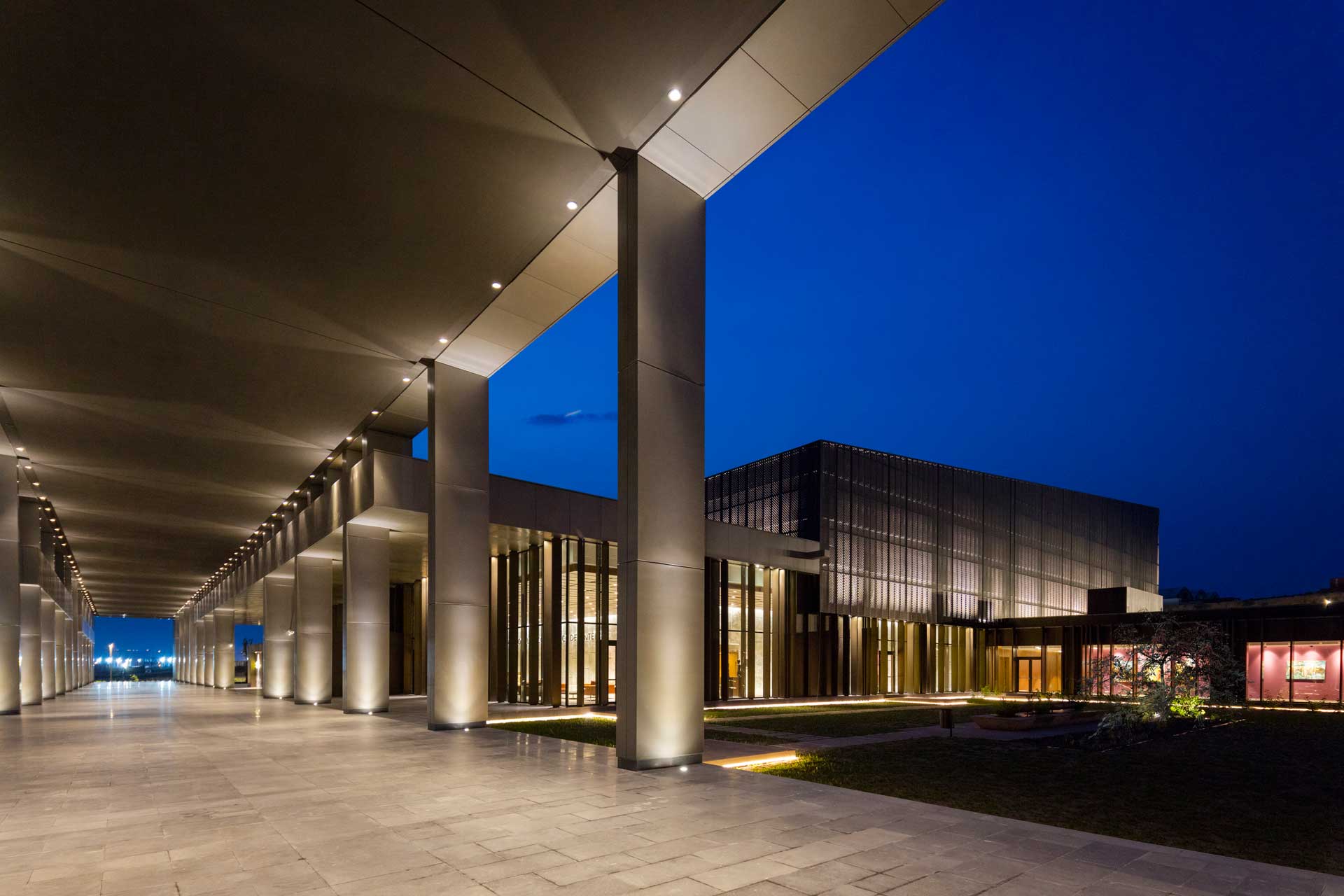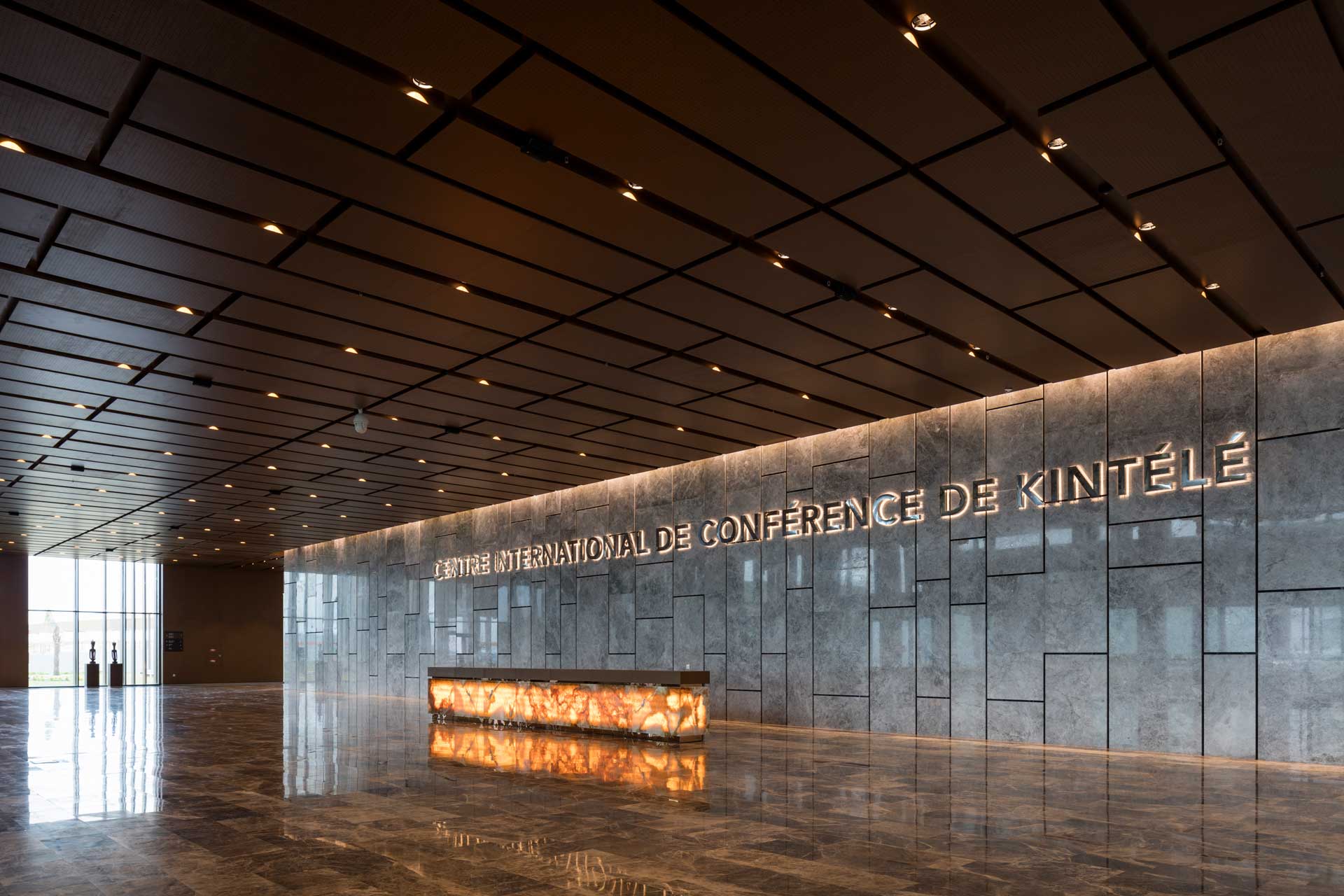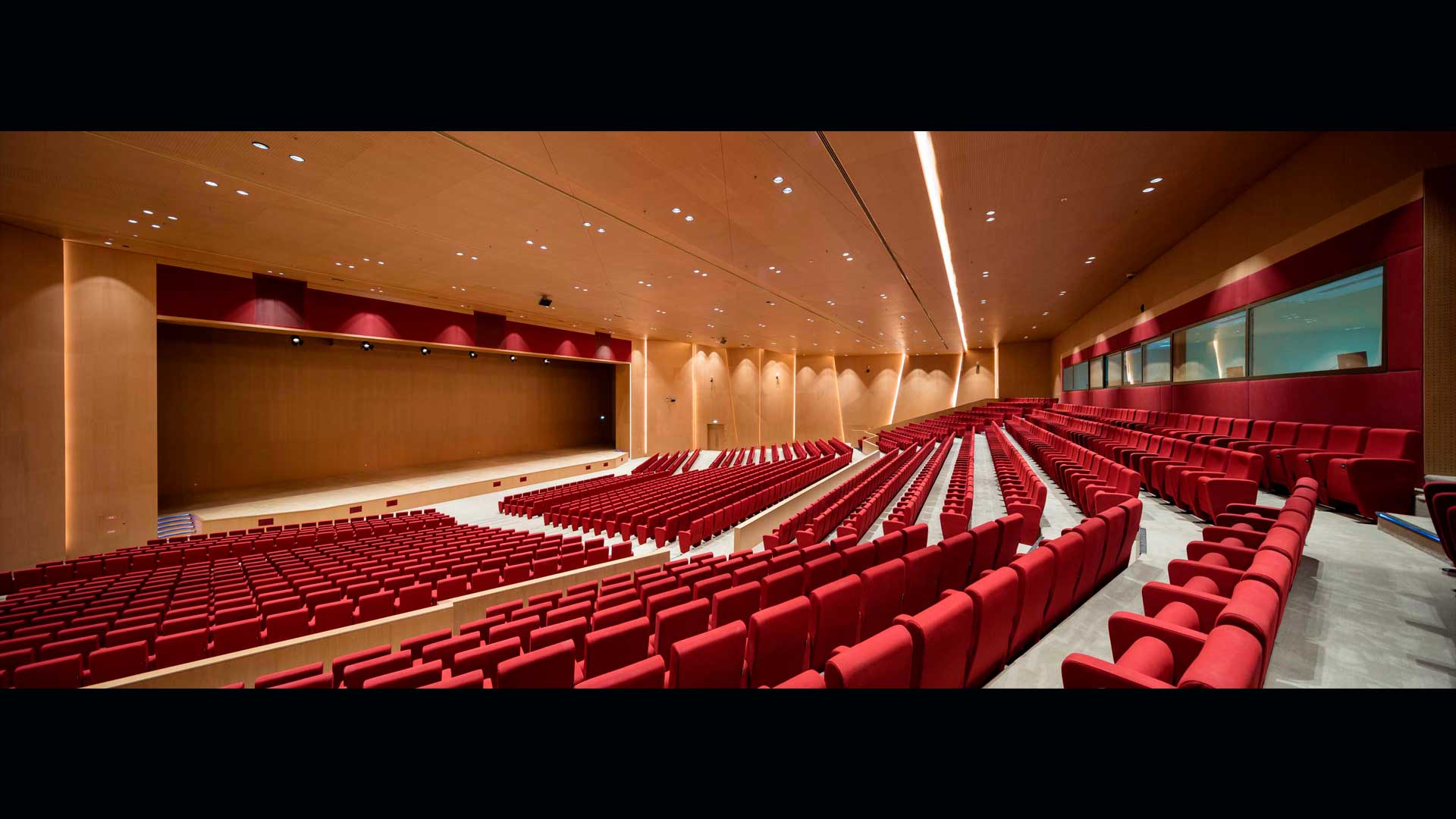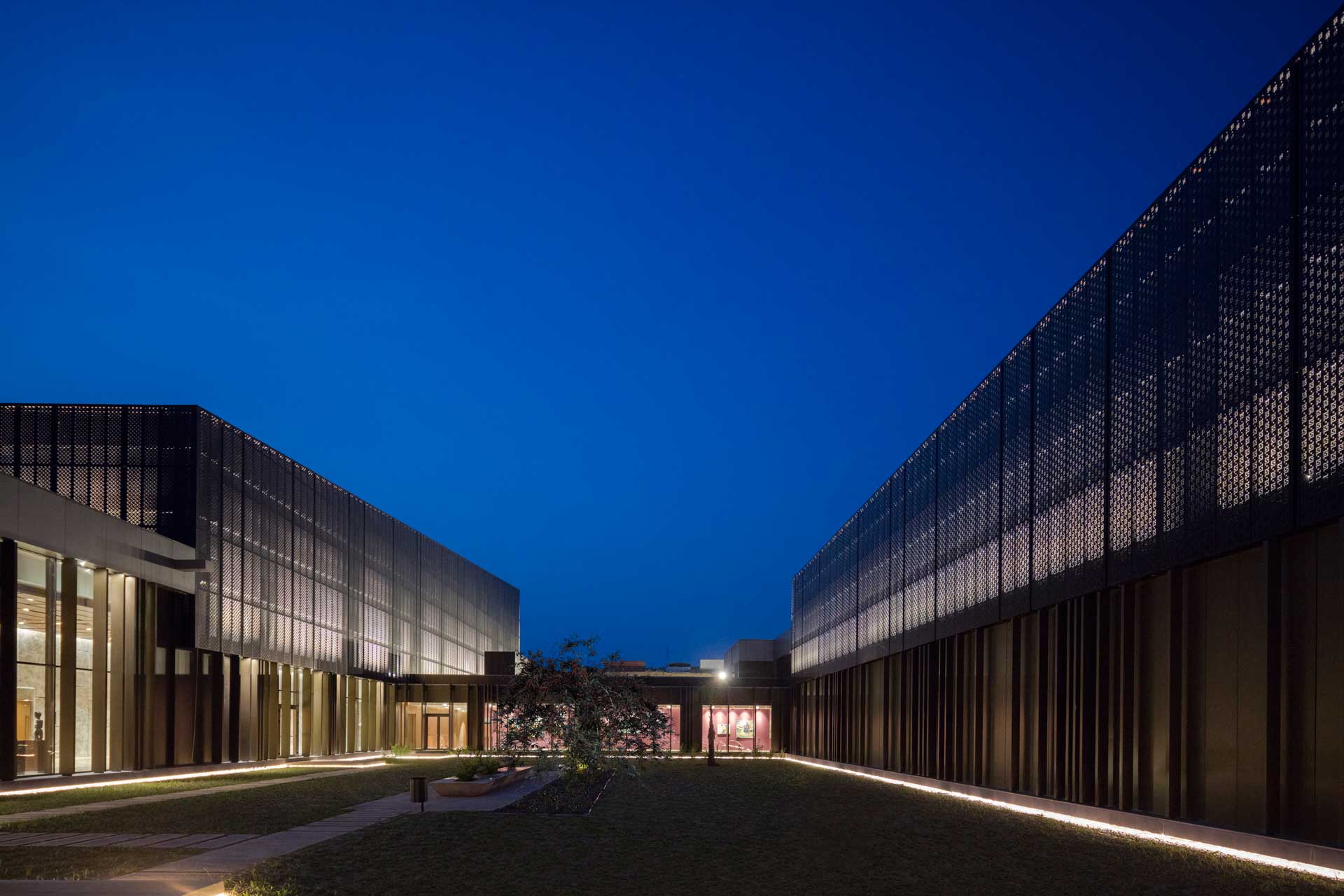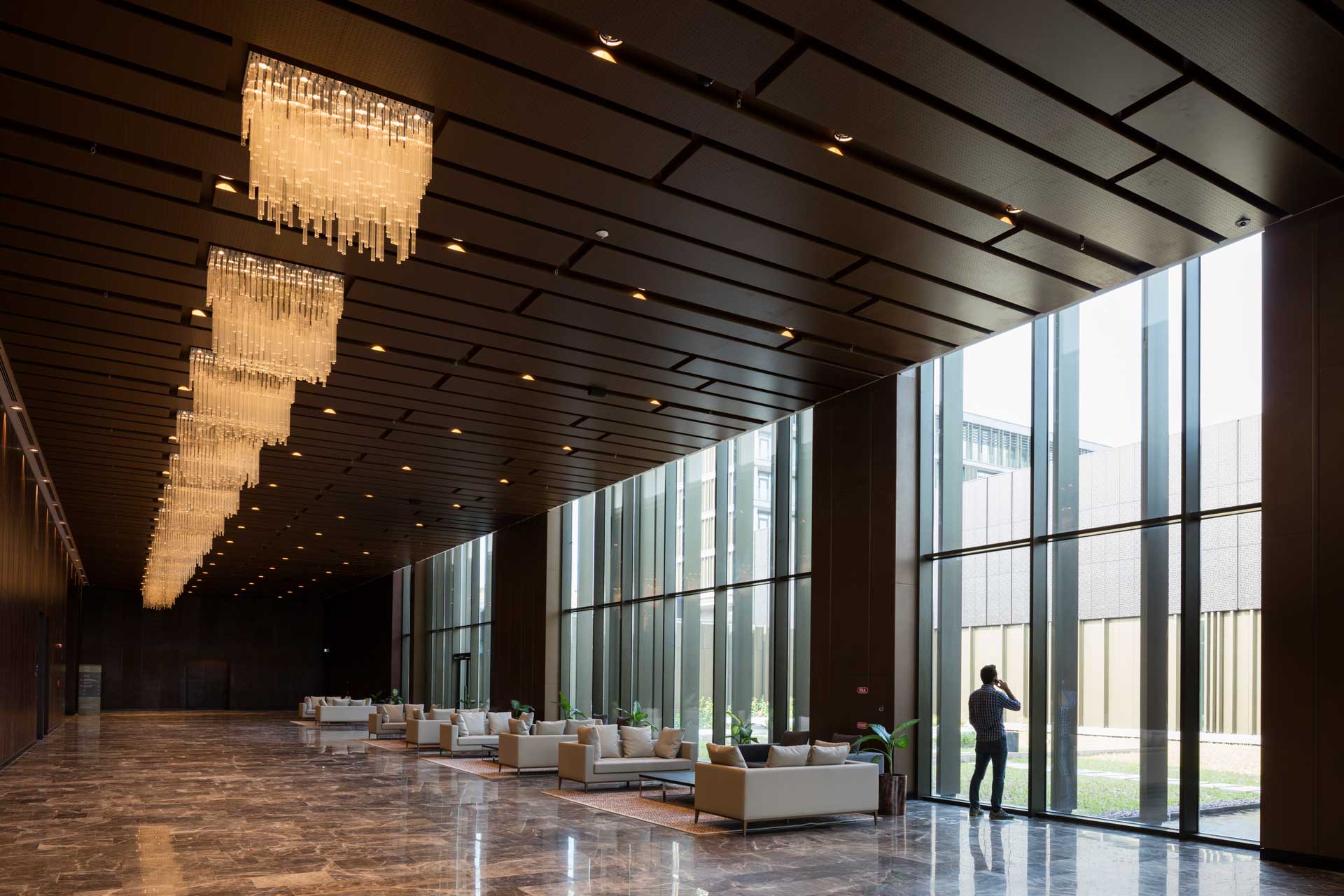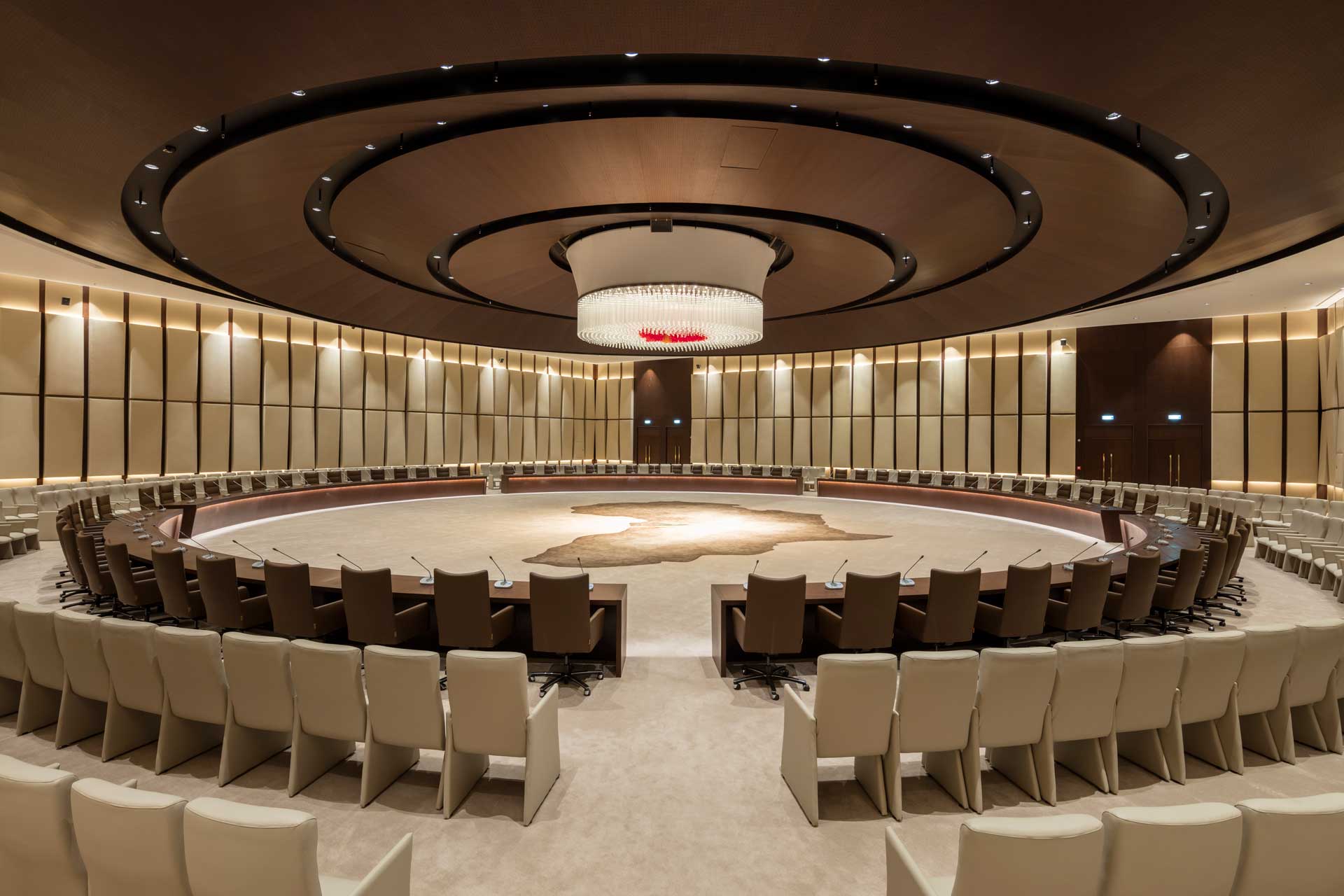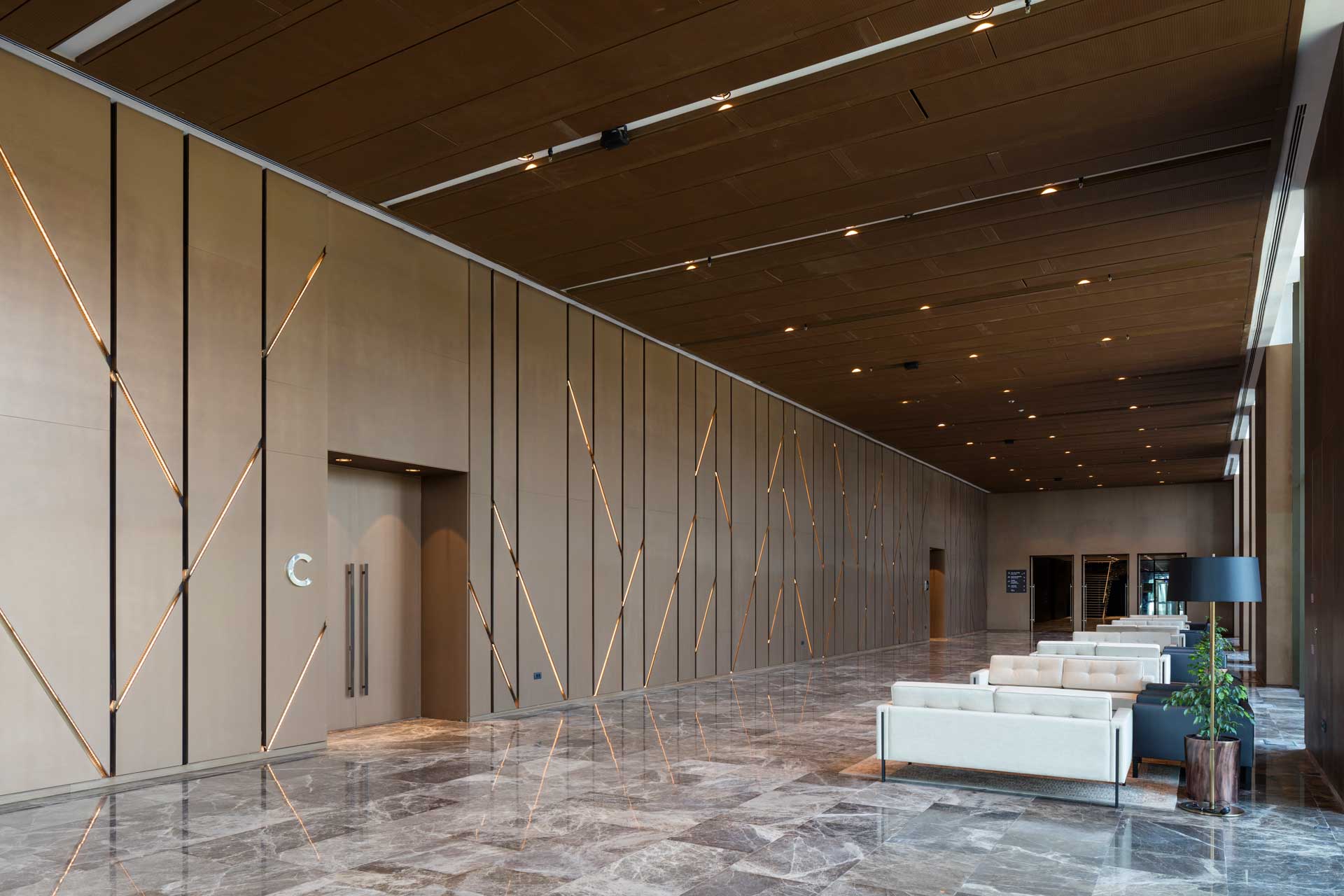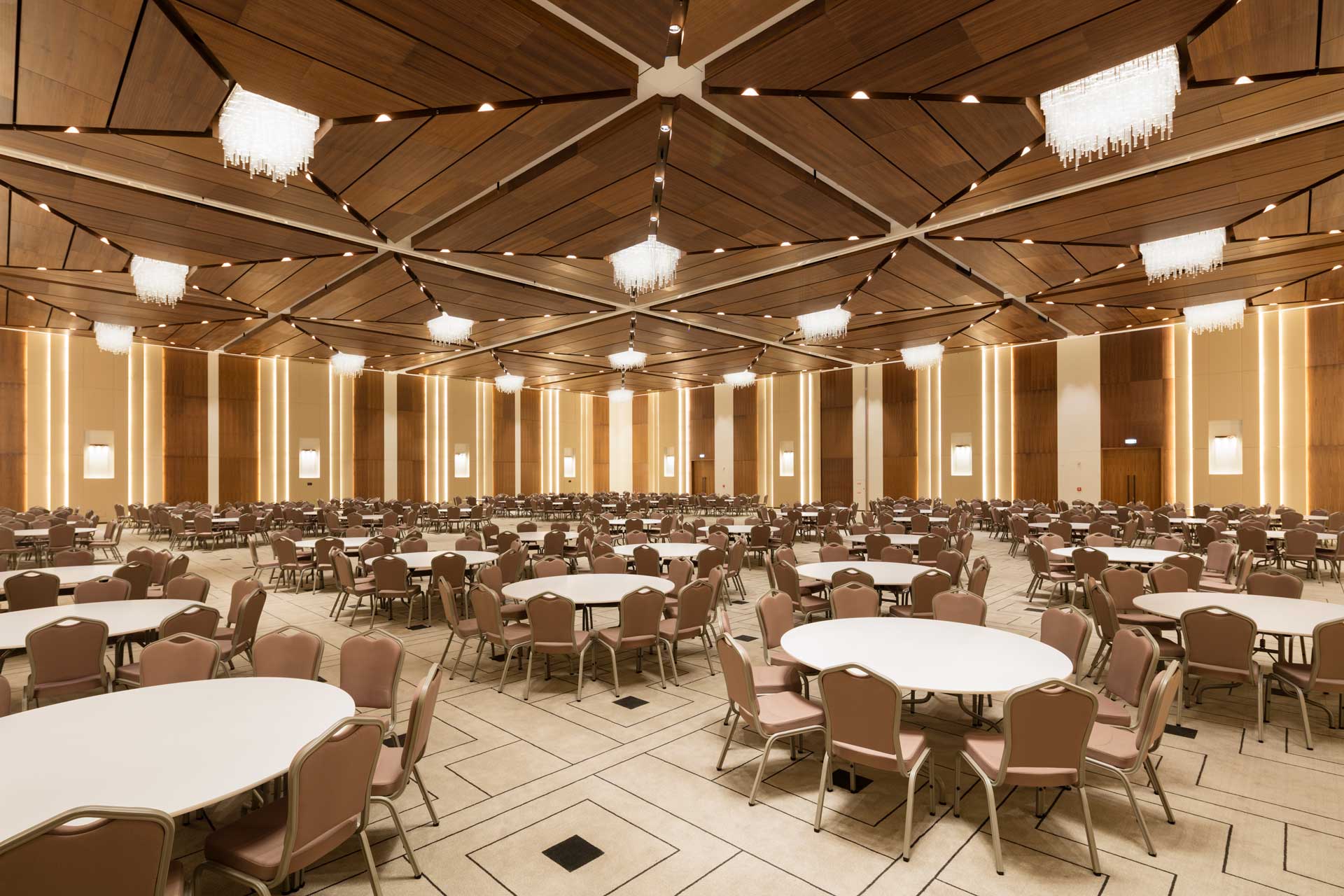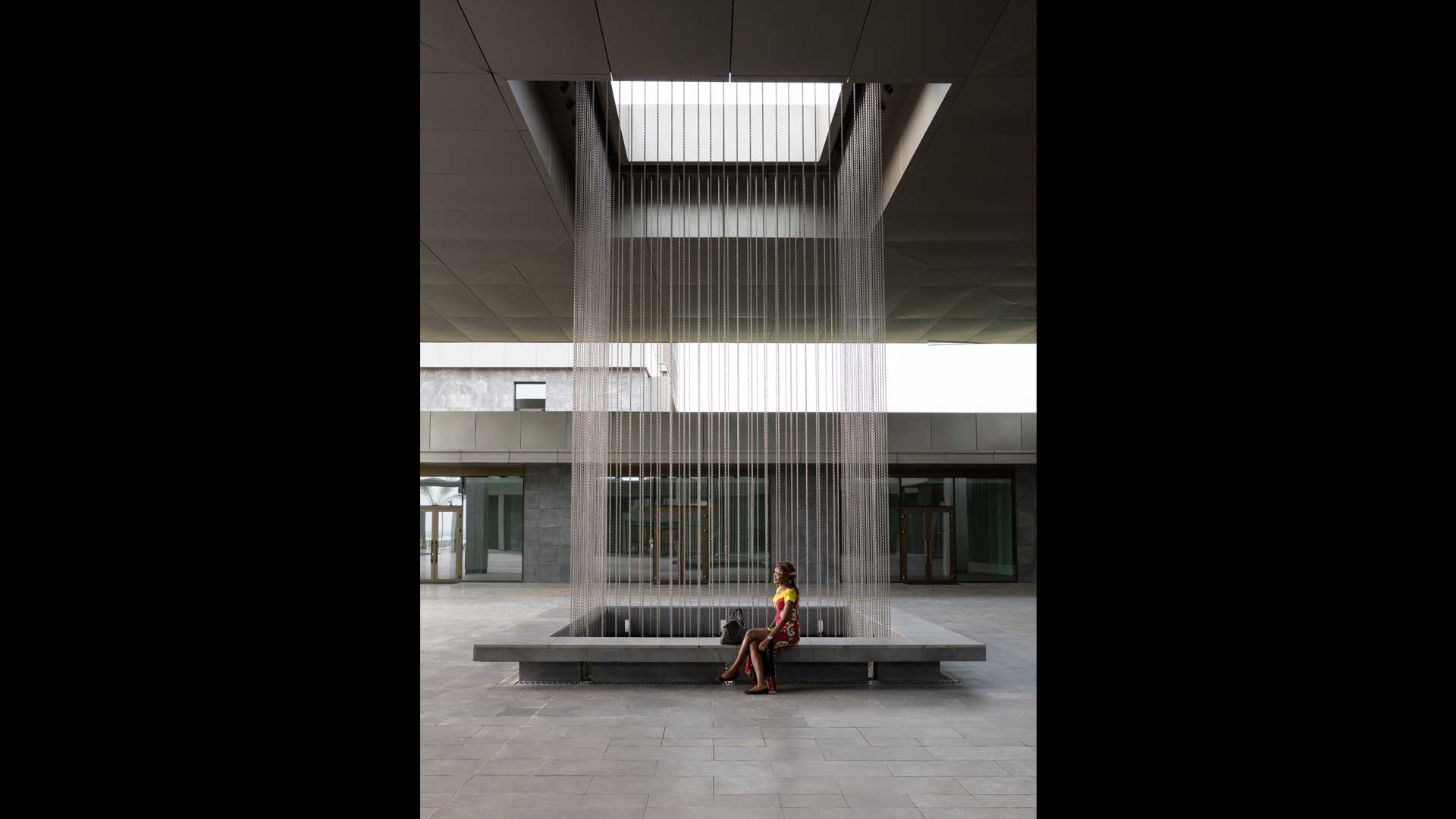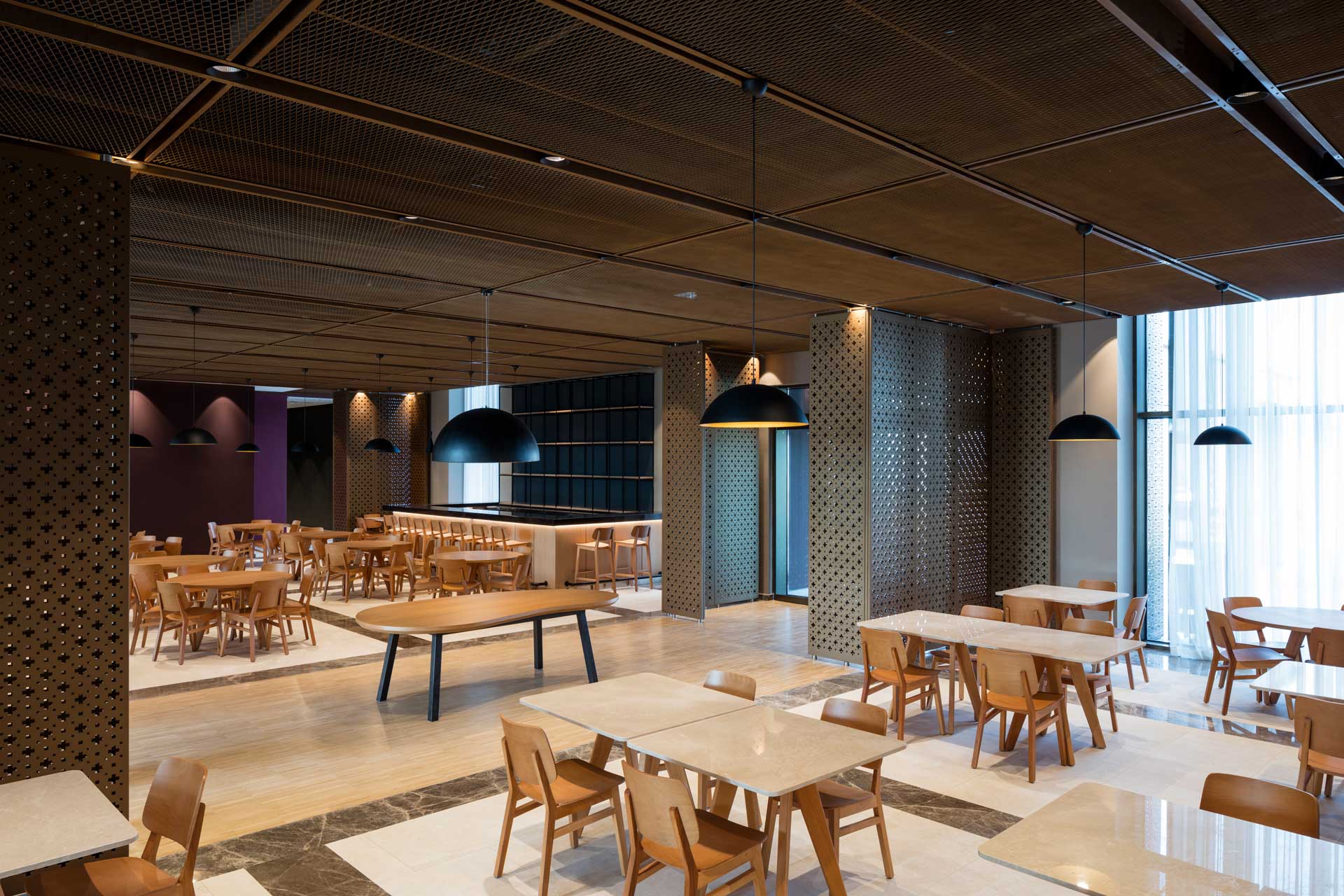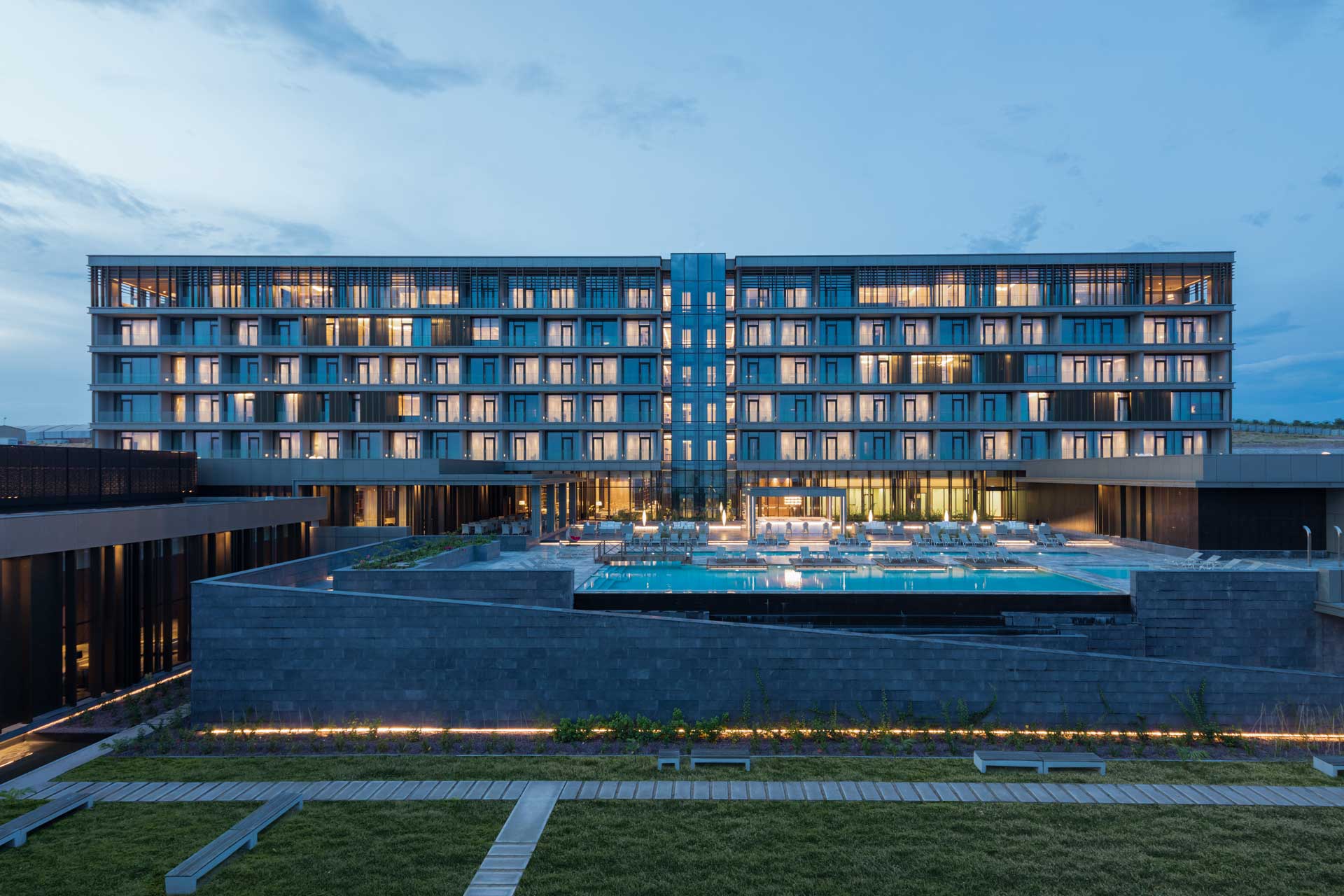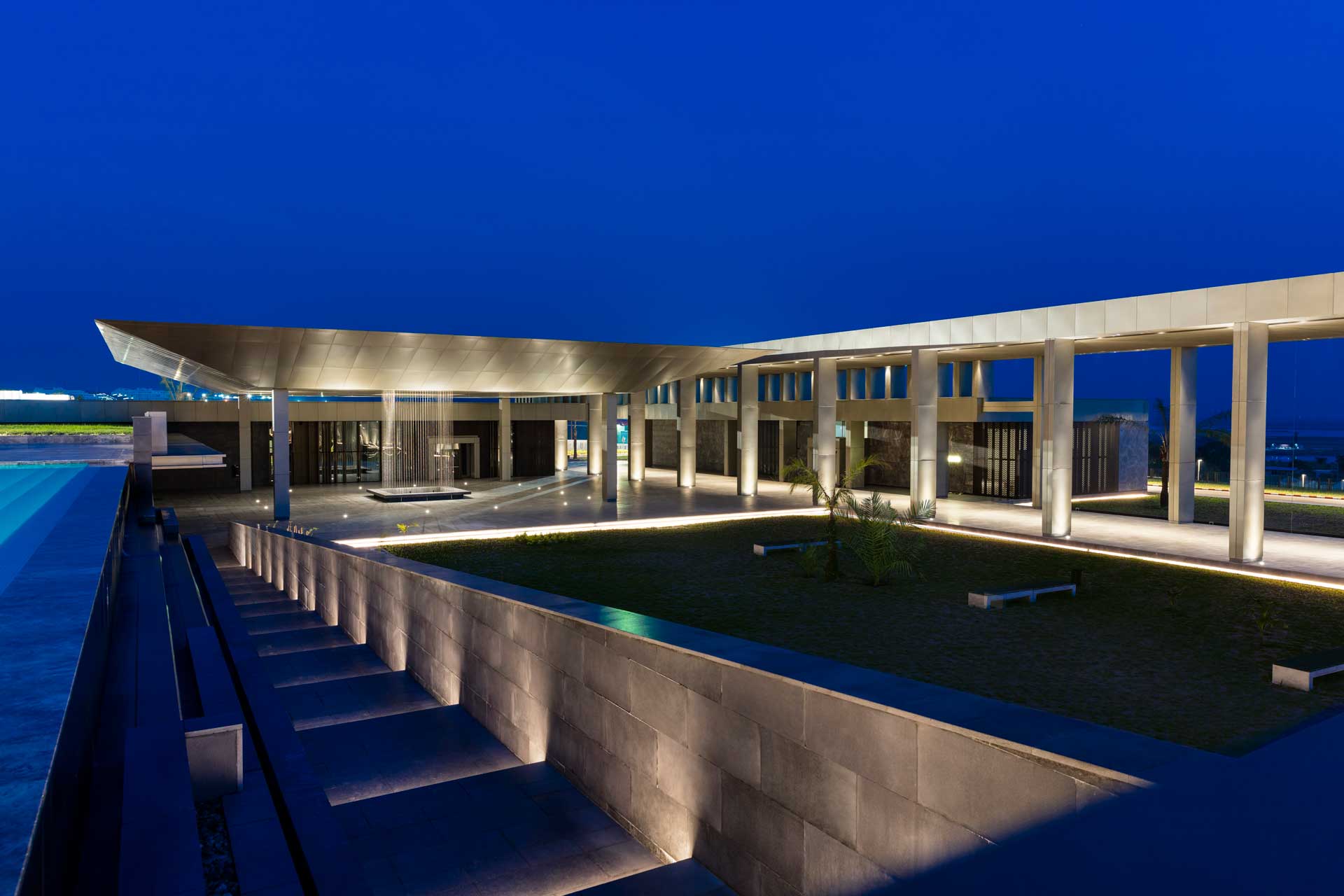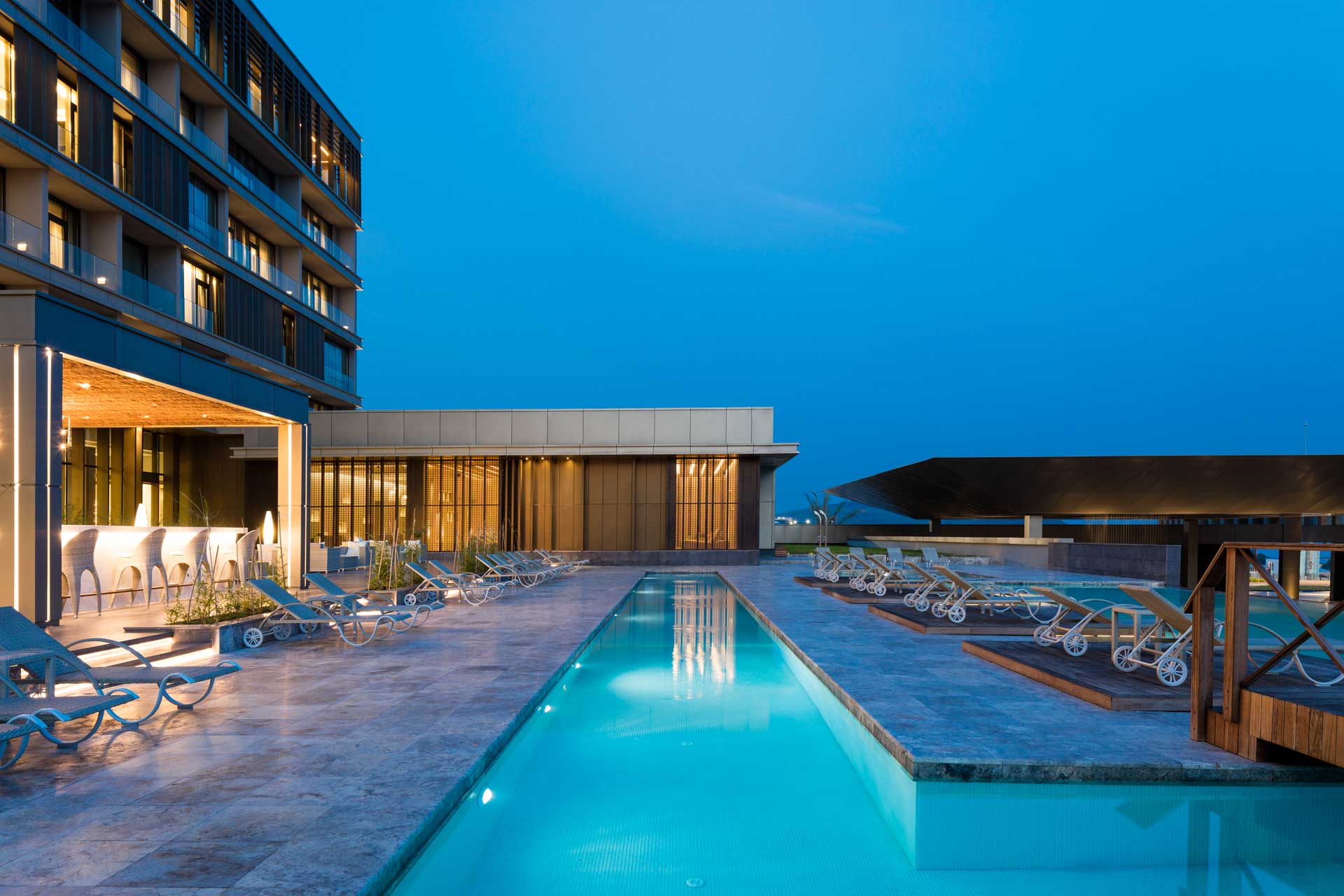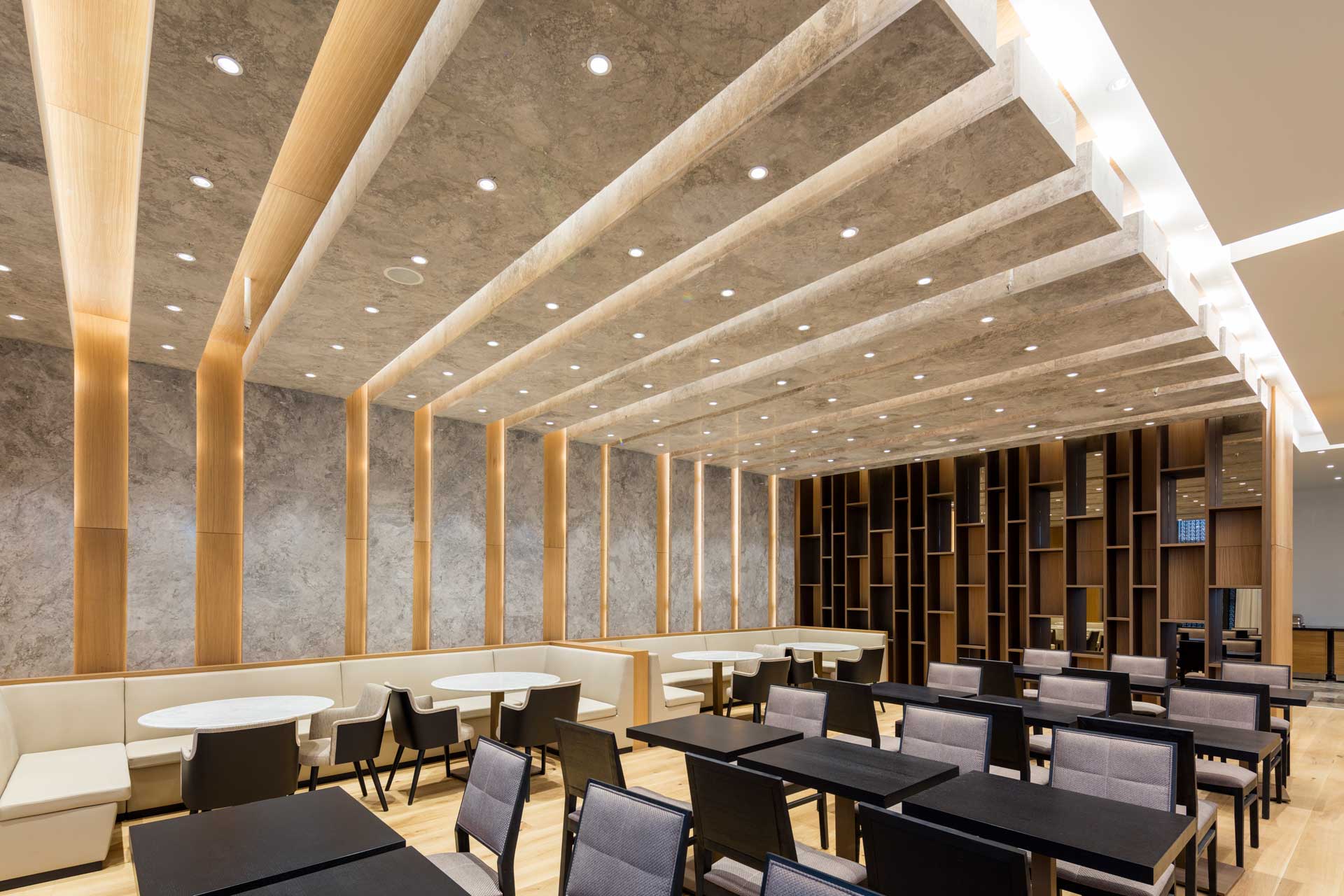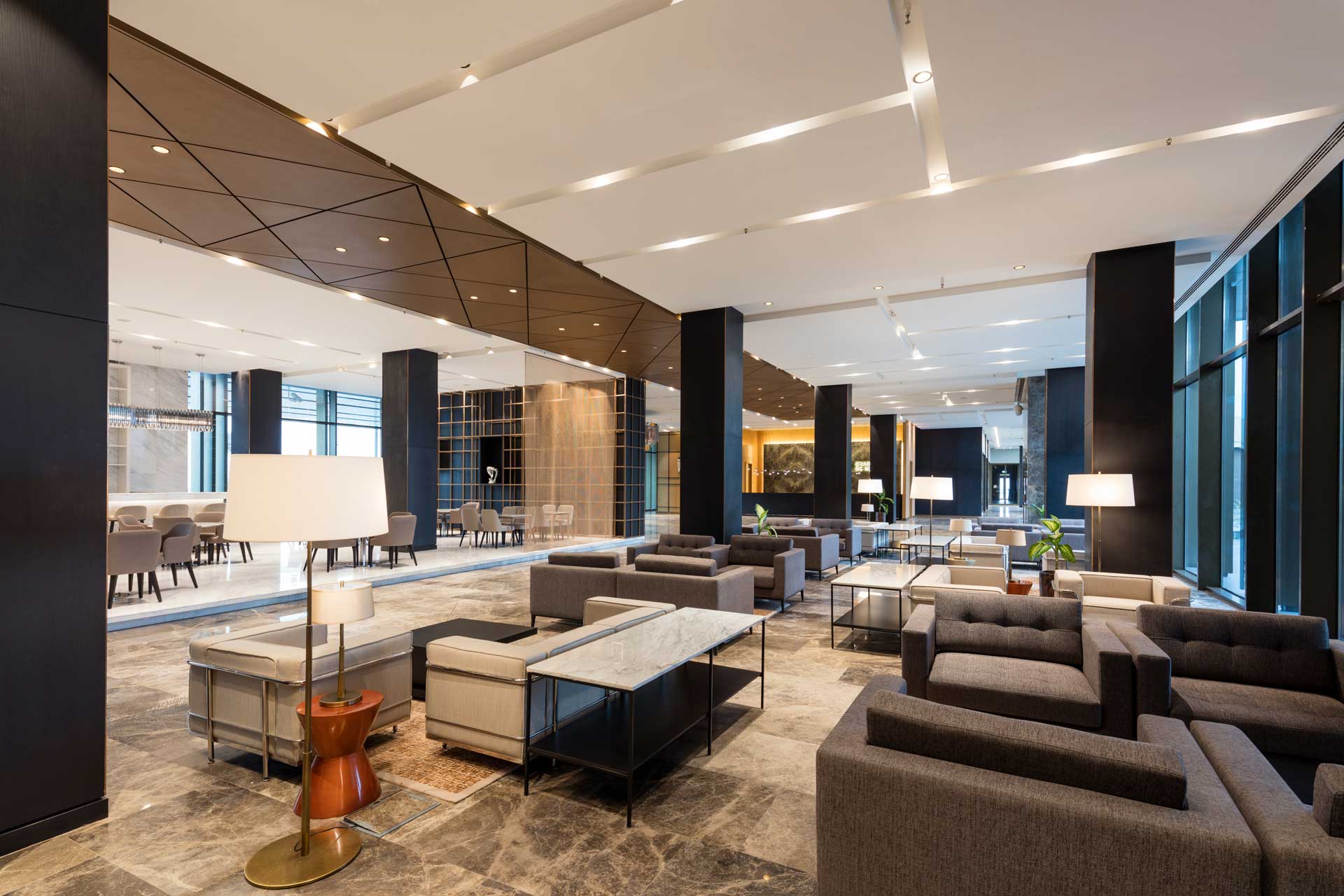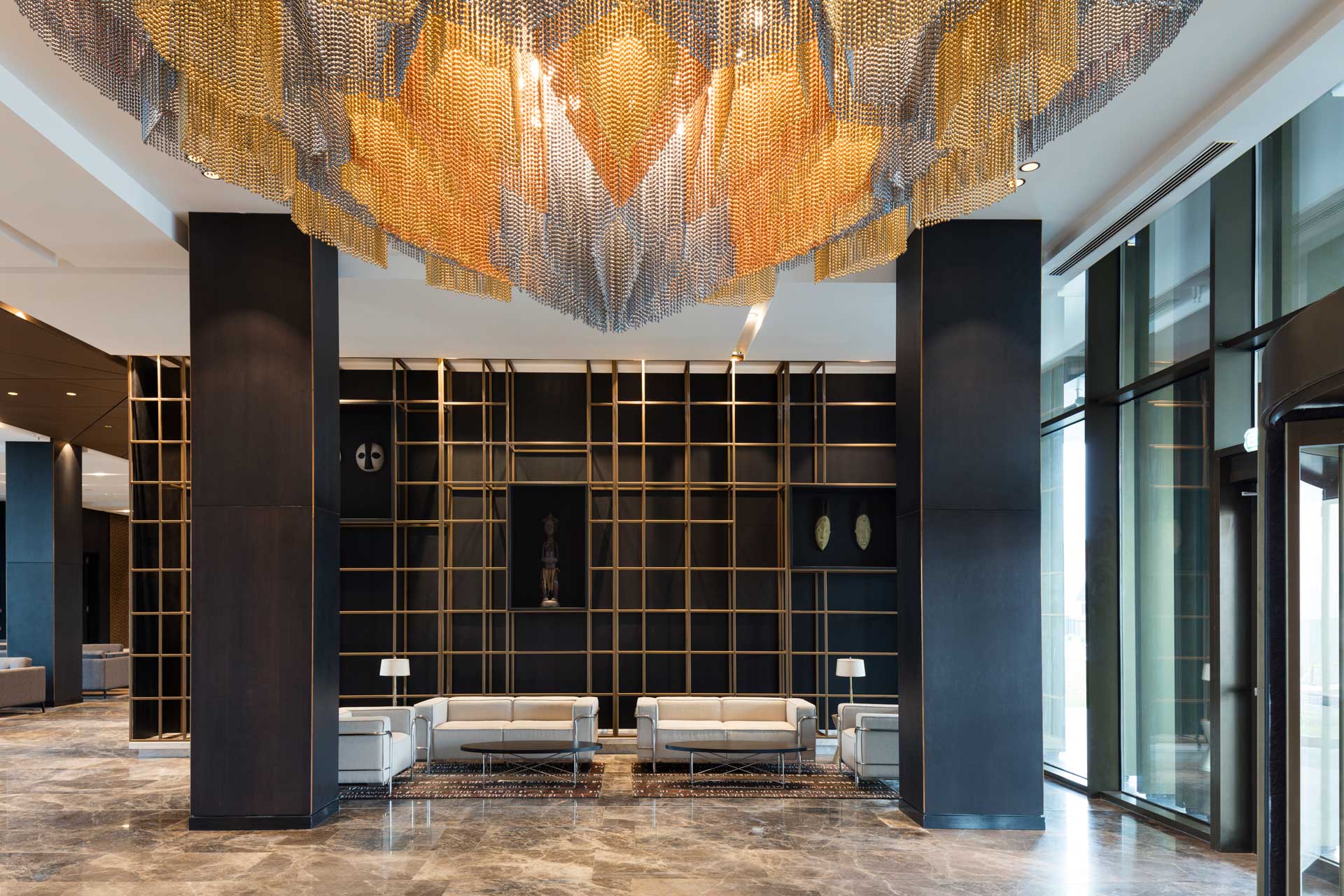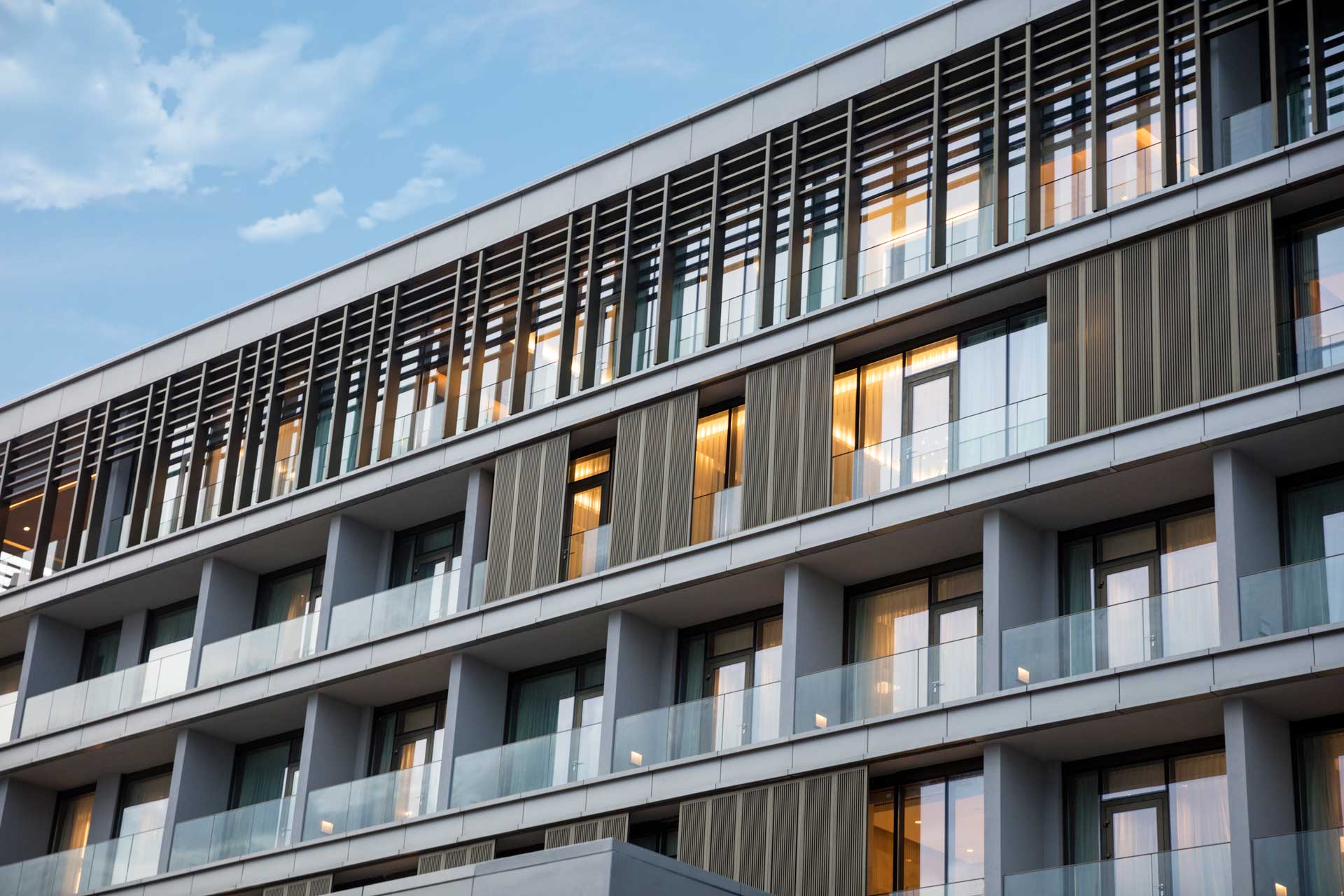CONGO CONGRESS CENTRE
The new Congo Kintele Congress Centre and Resort Hotel (KCC) is in a newly developing area of Brazzaville, to the north of the new Olympic Centre. The site has panaromic views of the Congo River to the south and a forested unbuilt landscape to the north. The topography of the site is a valley carved out by the great Congo River which creates an island M’Bamaou in the foreground and the buildings sit parallel to the contours of this valley falling towards the river.
CLIENT
SUMMA
SECTOR
Hotels, Mixed Use & Other
LOCATION
Congo, Kintele
YEAR
2015
DESIGN APPROACH
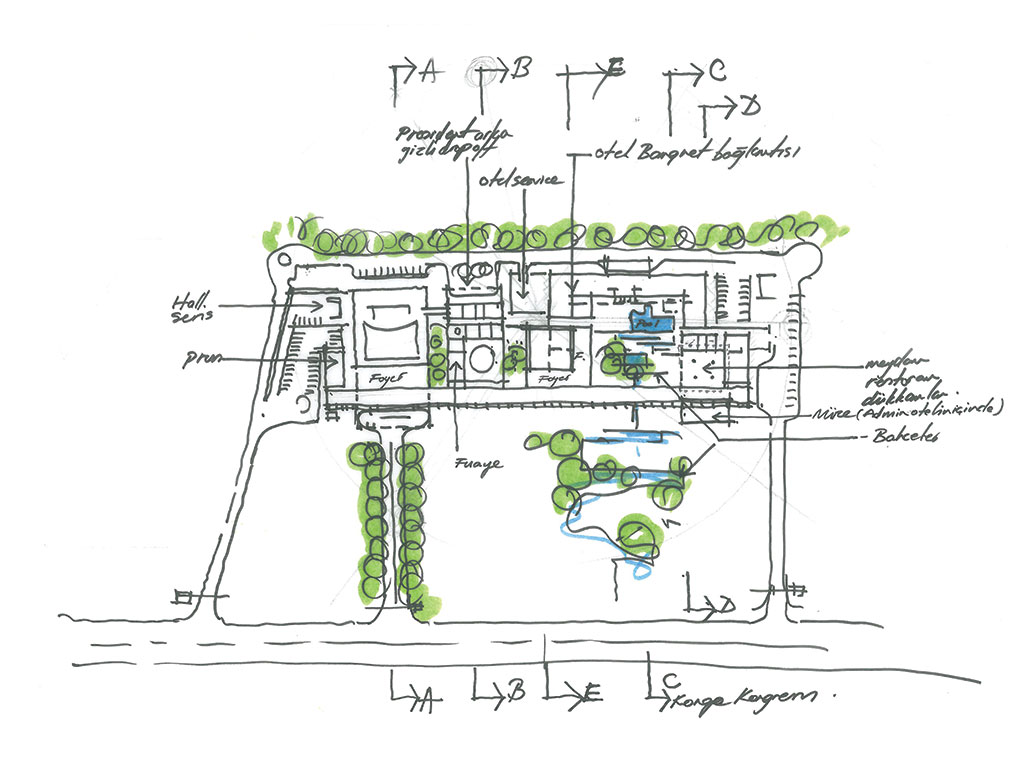
The positioning of the Congo Kintele Congress Center’s buildings on the site is largely dictated by this topography where we were concerned to minimise excessive excavation and shifting of earth away from the site. The larger objects of the programme: the 1500 seat Congress Hall, the 300 person Presidential Hall, the 1000 seat Banquet Hall and the 1000 person Public Piazza were placed in a line sequence interrupted by courtyards, and all reached by a public sheltered collonade that links these elements. The Hotel on the other hand is positioned 5 meters above this general public promenade, largely to give it better views to the river, while making a public / private segragation of functions on the site. All but two courtyards linking the enclosed volumes are accessible to the public, and allow us to form landscaped intermissions amongst the large masses of these functions. Thus the form of the Congo Kintele Congress Center settles in to the landscape, avoiding the appearance of an out of scale overbearing large mass of buildings while providing views of the Congo River from all hotel rooms.
The 350 meter long collonade also acts as a linear public space in itself sheltering people from the ever present rain that prevails most of the year around in this part of the world. The two ends of the Collonade also act as public gates to the whole complex. Attached to this public collonade are the Press Hall to the Western gate and Museum to the Eastern gate. At this end the Museum forms the southern edge of the Piazza, while the shops and the Public Restaurant form the Northern and Eastern edges of the Piazza. This open space is also sheltered from the rain with a square occulus that allows the rain to fall in to a shallow pool at its centre.
RELATIONSHIP WITH CLIMATE
In the Congo Kintele Congress Center’s location for at least 6 months of the year rain is an everpresent climate phenomenon in Congo and defines the way people interact in public and with public space. Therefore great effort was made in this sense to shelter people while out in the open but to not distance from nature, and the presence of rain because while it is raining it is still very warm and ofcourse humid. There fore while it is important to shelter from rain it is also important to allow air to flow and cool such sheltered spaces. The presence of water is celebrated by making its fall from roofs visible and audible as it reaches the earth and fills open pools which take overflow from large roof areas using gargoyles and water falls.
Another aspect of the local tropical climate is the constant presence of a high level of humidity which makes use of natural ventilation as a way of minimising energy consumption difficult and the use of airconditioning of public spaces essential for comfort conditions to be achieved to acceptable comfort standards. Our main objective in this case is to minimise the cooling loads by reducing the incidence of sunlight on exposed glass facades. Thus glazing is always deeply set in to the façade on the north (in this case it is actually the true north façade which receives the midday sun due to the location of the site below the equator) and low sunlight from the east and west is minimised by vertical shading elements and perforated metal screens.


SELECTION OF MATERIALS

The use of materials in the Congo Kintele Congress Center’s Resort Hotel were to a large extent dictated by the requirement of speed of construction, and availability of modern construction and cladding materials, of which none exist in The Congo Republic. Thus although it would be more cost effective, concrete frame was ruled out in favour of steel and more easily transportable lighter cladding materials such as aluminium panelling for massive cladding elements such as block or brick work. Beyond that efforts were made to use natural materials at all times such as timber, and stone.
FACADE PATTERNS
The larger elements are signified by a series of perforated cladding elements which are laser cut in geometric Congolese patterns derived from the traditions of the larger region, connecting the buildings to their place. At times these patterns find themselves recalled in interior elements such as floor patterns and screens which divide interior spaces, and at times on external wall elements creating shading or privacy between inside and outside. Vertical shading elements are a lighter coloured bronz/brass finish, set against a background of larger darker coloured panels and of course glass. The overall colour palatte of the project is infact derived from a series of lighter and darker shades of bronz and brass.
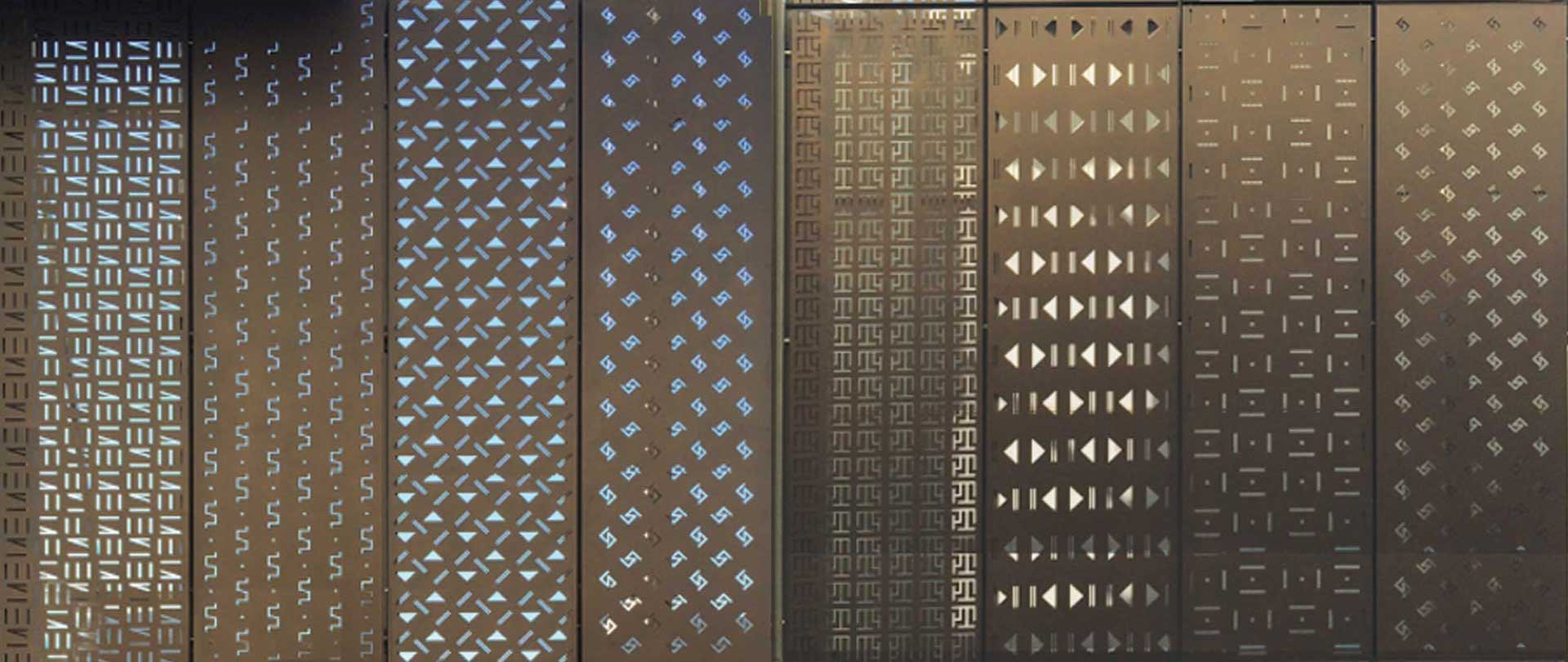
KINTELE RESORT HOTEL

The 200 bedroom resort hotel also acts as an adjunct to the Congo Kintele Congress Center, providing both facilities for some of the presidential guests, with 6 presidential suites and their entourage, with a series of suites and standard rooms. On the ground floor are the spa, restaurant, bars and the pool all of which stand 5 metres above the level of the Congress Centre, providing panoramic views across the Congo Valley.
Pedestrian links lead from the hotel pool side down to the major event courtyard below which also serves as an extension of the Public Piazza, which links again to the collonade running East West.
CONSTRUCTION PROGRESS PHOTOS
PROJECT TEAM
Employer:
The Republic of Congo
Architect:
AVCI ARCHITECTS
Design Team:
Selçuk Avcı, Deniz Nar, Arda Can Buze, Koray Tokdemir, Özge Öztürk, Tuğba Öztürk, Özgür Kayabay, Tuba Şehitoğlu, Hande Yarımbıyık, Gizem Saka Çakıroğlu, Deren Uysal, Egemen Karakaya, Serhat Aksu, Tolgahan Akbulut, Ezgi Halisçelik, Zehranur Güçmen
Interiors:
AVCI ARCHITECTS
Landscape Architect:
Sahara Peyzaj
Main Contractor:
SUMMA Turizm Yatırımcılığı
Structural Engineer:
Emir Mühendislik
Mechanical Engineer:
Metta Mühendislik
Electrical Engineer:
EMT Elektrik
İnfrastructure Design:
Ekiz&Ekiz Proje Danışmanlık
Fire Consultant:
Doç. Dr. Mustafa Özgünler
Acoustic Consultant:
Akustik İzolasyon Danışmanlık
Lighting Design:
ON/OFF Aydınlatma Tasarım
Signage and Graphics:
AVCI ARCHITECTS
Substructure:
Steel Frame
Photographer:
Emre Dörter




